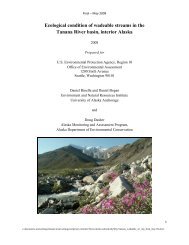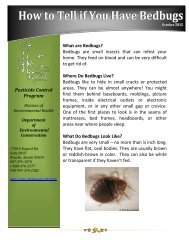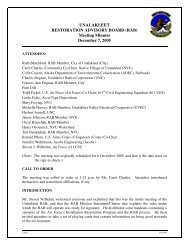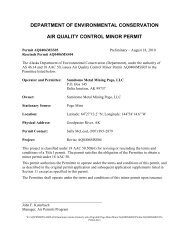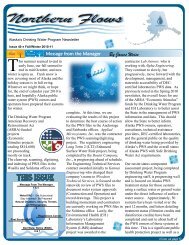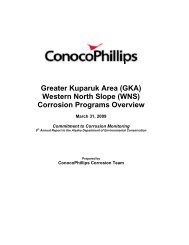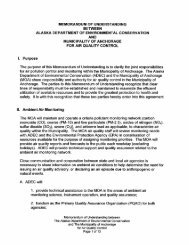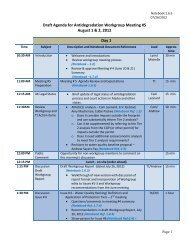2012 Ocean Ranger Guidebook Revision 3-7-12 - Alaska ...
2012 Ocean Ranger Guidebook Revision 3-7-12 - Alaska ...
2012 Ocean Ranger Guidebook Revision 3-7-12 - Alaska ...
You also want an ePaper? Increase the reach of your titles
YUMPU automatically turns print PDFs into web optimized ePapers that Google loves.
<strong>20<strong>12</strong></strong> <strong>Ocean</strong> <strong>Ranger</strong> <strong>Guidebook</strong> 3-7-<strong>12</strong><br />
In 2011 ADEC and its opacity contractor took 235 Method 9 readings of large and<br />
small cruise ships and ferries. CPVEC also receives public complaints regarding cruise ships and<br />
ferries. Eleven complaints were received in 2011. CPVEC also received 33 self-reports of excess<br />
emissions (under 18 AAC 50.240) from cruise ships.<br />
<strong>Ocean</strong> <strong>Ranger</strong>s are not trained to perform opacity readings but have contributed<br />
significantly to the cruise programs opacity monitoring by reporting cases of heavy smoke, soot,<br />
and equipment failures. They have also documented many operators effectively and<br />
successfully minimizing emissions to meet the opacity limits.<br />
Opacity is a surrogate for air pollution. There are many types of air pollution, such as<br />
oxides of nitrogen, sulfur, and carbon, particulates, volatile organic components, and<br />
carcinogens. While it would be more difficult to measure all of these parameters, visible opacity<br />
is used to<br />
General opacity background information:<br />
Opacity is the reduction of transmitted light caused by particles, mists, or gases. It can<br />
be caused by partially burned fuel or ash from the combustion processes. Opacity was originally<br />
measured using the Ringelmann scale which used grids to compare to the opacity of the smoke.<br />
It only worked well with black smoke, and was replaced with EPA Method 9. The Ringelmann<br />
method did introduce the 20% limit, which was based on increasing the efficiency of<br />
combustion. The idea was that over 20% would show incomplete combustion.<br />
Method 9 is a visual method that requires training and certification. The method<br />
contains requirements that are designed to reduce potential bias. Because of the requirements<br />
for angles and distances from the stack it would be difficult to have <strong>Ocean</strong> <strong>Ranger</strong>s perform<br />
opacity readings onboard. More information on opacity readings can be found in the reference<br />
part of this section.<br />
Subsection 1: Opacity (Visible Emissions); Air Quality<br />
Job Aid Item: 4.1.a<br />
Text: Stack emissions are minimized and monitored. Operational (combustion) procedures in place.<br />
(18 AAC 50.070)<br />
Background: Cruise Ships in <strong>Alaska</strong> often monitor air emissions using opacity meters (Continuous<br />
Opacity Monitoring System (COMS)) and with visual checks by video camera located on the stack or in<br />
person. Most ships have procedures on keeping emissions below the regulatory limit.<br />
Please note that opacity meters can be useful onboard, but may not match the visible opacity as there<br />
are many factors including calibration, equipment error, and levels alarms are set at.<br />
151






